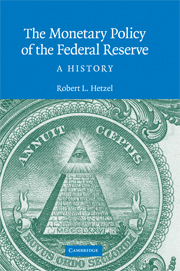Book contents
- Frontmatter
- Contents
- Figures
- Preface
- 1 The Pragmatic Evolution of the Monetary Standard
- 2 Learning and Policy Ambiguity
- 3 From Gold to Fiat Money
- 4 From World War II to the Accord
- 5 Martin and Lean-against-the-Wind
- 6 Inflation Is a Nonmonetary Phenomenon
- 7 The Start of the Great Inflation
- 8 Arthur Burns and Richard Nixon
- 9 Bretton Woods
- 10 Policy in the Ford Administration
- 11 Carter, Burns, and Miller
- 12 The Political Economy of Inflation
- 13 The Volcker Disinflation
- 14 Monetary Policy after the Disinflation
- 15 Greenspan's Move to Price Stability
- 16 International Bailouts and Moral Hazard
- 17 Monetary Policy Becomes Expansionary
- 18 Departing from the Standard Procedures
- 19 Boom and Bust: 1997 to 2001
- 20 Backing Off from Price Stability
- 21 The Volcker–Greenspan Regime
- 22 The Fed: Inflation Fighter or Inflation Creator?
- 23 The Stop–Go Laboratory
- 24 Stop–Go and Interest Rate Inertia
- 25 Monetary Nonneutrality in the Stop–Go Era
- 26 A Century of Monetary Experiments
- Appendix: Data Seen by FOMC for the Stop–Go Period Shown in Figures 24.1, 24.2, and 24.3
- Notes
- Bibliography
- Index
- Titles in the series
Preface
Published online by Cambridge University Press: 26 May 2010
- Frontmatter
- Contents
- Figures
- Preface
- 1 The Pragmatic Evolution of the Monetary Standard
- 2 Learning and Policy Ambiguity
- 3 From Gold to Fiat Money
- 4 From World War II to the Accord
- 5 Martin and Lean-against-the-Wind
- 6 Inflation Is a Nonmonetary Phenomenon
- 7 The Start of the Great Inflation
- 8 Arthur Burns and Richard Nixon
- 9 Bretton Woods
- 10 Policy in the Ford Administration
- 11 Carter, Burns, and Miller
- 12 The Political Economy of Inflation
- 13 The Volcker Disinflation
- 14 Monetary Policy after the Disinflation
- 15 Greenspan's Move to Price Stability
- 16 International Bailouts and Moral Hazard
- 17 Monetary Policy Becomes Expansionary
- 18 Departing from the Standard Procedures
- 19 Boom and Bust: 1997 to 2001
- 20 Backing Off from Price Stability
- 21 The Volcker–Greenspan Regime
- 22 The Fed: Inflation Fighter or Inflation Creator?
- 23 The Stop–Go Laboratory
- 24 Stop–Go and Interest Rate Inertia
- 25 Monetary Nonneutrality in the Stop–Go Era
- 26 A Century of Monetary Experiments
- Appendix: Data Seen by FOMC for the Stop–Go Period Shown in Figures 24.1, 24.2, and 24.3
- Notes
- Bibliography
- Index
- Titles in the series
Summary
What is the monetary standard? How does the Fed control inflation? Not only is there little consensus over answers to these questions, but there is also little consensus over how to organize the monetary experience of the twentieth century in a way that can discriminate between competing answers.
As a member of the Money and Banking Workshop at the University of Chicago, I had the privilege of listening to Robert Barro, Stanley Fischer, Robert Gordon, Robert Lucas, Bennett McCallum, Donald Patinkin, and, of course, Milton Friedman. I left Chicago for the Federal Reserve Bank of Richmond in 1975 with several assumptions about monetary economics: (1) the price level is a monetary phenomenon; (2) the price system works; and (3) the public learns to form its expectations in a way that conforms to the Fed's monetary policy (rational expectations).
Paul Volcker demonstrated that not only could the Fed control inflation, but that it could also do so without permanently high unemployment or periodic recourse to high unemployment. Conversely, low stable unemployment did not require monetary management through high, variable inflation. As a result, there is now considerable agreement over assumptions 1 and 2. The central bank, which possesses a monopoly over monetary base creation, controls trend inflation. As described by real business cycle models, the price system works well to offset shocks. However, economists still divide over the nature of inflationary expectations.
Is there inertia in inflationary expectations and in inflation independent of the systematic component of monetary policy?
- Type
- Chapter
- Information
- The Monetary Policy of the Federal ReserveA History, pp. xiii - xviPublisher: Cambridge University PressPrint publication year: 2008

